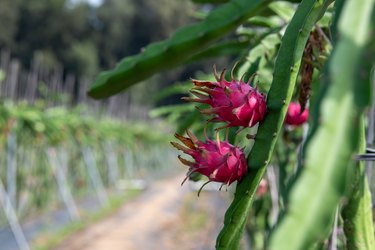
You've passed them in the produce aisle of your market and may wonder what those colorful, neon-pink Sputnik-like balls are and how you go about growing them. They are known as Dragon Fruit (Hylocereus undatus) among other names, and are actually one of the healthiest fruits on the produce stand. Exotic in appearance, with pink thorns rimmed in light green, the dragon fruit is actually a member of the cactus family and requires desert-like growing conditions, flourishing best in U.S. Department of Agriculture hardiness zones 10a-11.
Growing your own requires a cactus soil mix and an environment with outdoor temperatures ranging from 65 to 80 degrees Fahrenheit. In the U.S., dragon fruit is commercially grown in Southern California, Florida and Hawaii, with many imports coming from Mexico, Central and South America.
Video of the Day
Video of the Day
Growing Your Own Dragon Fruit
The dragon fruit with the pink exterior and white flesh is the most familiar version of the fruit and the one most commercially grown. Other types include a yellow exterior with white flesh and a variety with both a red exterior and interior.
Dragon fruit soil should be sandy and slightly acidic, with a pH level between 6 and 7. In the absence of sandy soil, be sure to use a growing medium that is well draining if you are planting your dragon fruit in a container, as its roots dislike being water-logged. If you are using a commercial potting soil, make sure it's designed for growing cactus.
Planting Guidelines for Dragon Fruit
When growing dragon fruit outdoors, be sure the plant is stabilized with a trellis or other support, as the fruit is heavy and can drag the mother plant down. This is a vining cactus that can grow from 5 to 10 feet. Choose a spot, whether in the garden or a container, that gets full sun or at least six hours of sun a day. Place the container in a sunny, warm spot. Plant outdoor vines close to a building for warmth if the weather in your area could dip below 40 degrees Fahrenheit.
Choose a large terracotta pot to avoid having to repot the plant. The terracotta drains well, and this desert cactus needs a good supply of water. While the plant does need more water than the average cactus, an inch of water each week should be enough, but test the soil for moistness to at least 1 inch deep. New stem pieces falling off the main vine is indicative of too much water.
The Best Fertilizer for Dragon Fruit
Once the dragon fruit has been planted, wait about a month before adding fertilizer. The first year requires fertilizer every two months using a 6-6-6 balanced mixture. Add organic compost or manure around the base of the plant, but don't let it touch the stem. Gradually increase the amount of fertilizer applied as the plant ages. Add a bloom-boosting fertilizer, one that has a higher potassium and phosphorus content for a late season shock.
Mulching also helps retain moisture as the season progresses. For an outdoor garden, the mulch repels weeds and adds to the health of the soil adjacent to the stem. A 2 to 6-inch layer adjacent to, but not touching, the stem is suggested.
The excitement of the dragon fruit comes when the flowers emerge, and that occurs during the night and only for one day. The fragrance is intense, but if you miss it, it won't happen again until the next growing season. Those flowers turn into the dragon fruit, which in itself, is an exciting accomplishment.